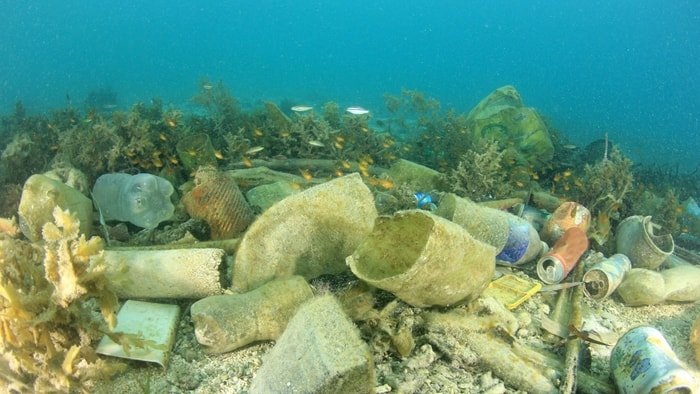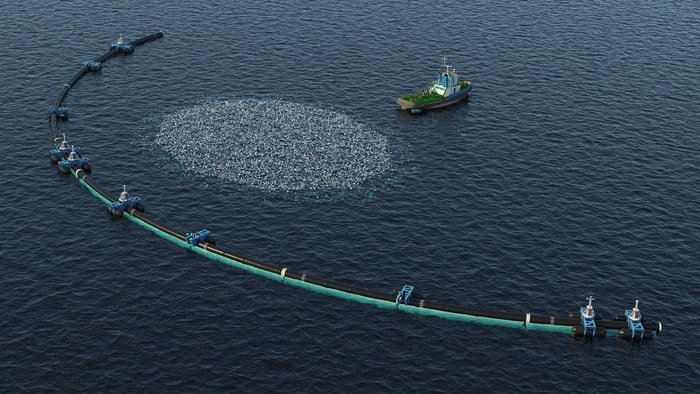Last Updated on October 11, 2024
We have long been aware of just how damaging throwing away plastic is for the environment. One of the most endangered areas of our planet is the ocean. It has become a humanities dumpster. It is so vast that most of us do not get to see the effects of ocean dumping, but more and more they are showing.
With campaigns like 4Ocean, we have been making efforts to clean out the large plastic waste that ruins life for a lot of species and pollutes our beaches. But there is a hidden threat in the water that is undetectable in plain sight. Today we are going to discuss microplastics in seafood. How does plastic in fish affect humans?
Table of Contents
Effects of Ocean Plastic Dumping and What Are Microplastics?
According to the National Ocean Service (NOAA) microplastics are small pieces of plastic that end up in the water and pollute our seas. They can be harmful to our ocean and aquatic life, as they are obviously not biodegradable.
Just how small are they? Less than 5mm. That is less than 0.2 inches. And they are everywhere. Even in the Arctic.
Microplastics are usually made out of polypropylene (commonly used for bottle caps and rope) and polyethylene terephthalate (commonly used for drink bottles). The beauty industry is the most serious offender, as they are added to exfoliating products like cleansers or toothpaste. These are called microbeads.
This is not the only source of microplastics, though, as they can also come from large plastic debris that degrades into smaller pieces.
How Do Microplastics Affect The Environment?
The real issue is that these beads and debris are so tiny that they are able to pass through water filtration systems and eventually end up in water bodies, harming aquatic life.
The microbead issue is not recent, as they have been used in beauty products as far back as 50 years ago. Nevertheless, their use was still widely spread as recently as 2012.
There is not much known about microplastics and how they affect human and ocean life yet. It is a new field of study that is eager to determine how much of a threat they are to our lives and the environment.
You can see the impact of microplastics in sea life in this article by National Geographic.
Why Do Fish Contain Microplastics?
The main reason, apart from them being so small, is that microplastics look a lot like food.
We are not talking only about microbeads, so the 2015 bill passed by Obama where the US banned them from the market is not enough. Bigger plastics are broken down by wind, waves, and sunlight until it becomes invisible plastic waste. Invisible but possibly deadly for fish.
If fish are eating plastic thinking it is food, they are not eating the necessary amount of calories they need to survive. Without fish, 3 billion people, marine animals, and seabirds would not have the critical protein they need daily.
Why Are Microplastics So Dangerous To Marine Life?
Even if the fish do survive, they would still be filled with these microplastics that would end up either on the insides of other animals or on our tables. A study conducted in England showed that, from 50 marine animals, all of them contained microplastics.
Why Microplastics
These tiny pieces of plastic are not only in the fish’s gut though. They can reach their bloodstream. Before, scientists thought that they just passed through the animal’s digestive tract without any issues, but they can move out of the gut and end up in other organs or inside their veins.
Scientific American points out that scientists have found evidence of damage caused to organs, such as inflammation, by such particles rubbing or jamming certain parts of the animal’s body.
In that article, they also quote a study that shows that microplastics affect sealife’s life cycle by making them reproduce less. Some species have not had any side effects, but others have experienced toxic effects from exposure to certain kinds of plastic.
It is clear that this threat is everywhere, but it is hard to know if it is actually something we, as a regular consumer, need to be concerned about.

What Can We Do To Reduce Microplastic Pollution?
First of all, we should always be mindful of our own patterns of consumption and waste. The best possible way of stopping this is to not generate waste in the first place or to recycle all or most of our plastic waste. Reduce, reuse, recycle should be our mantra. Check out this store to help you achieve that goal.
Still, the World Health Organization is not sure about how much of a risk microplastics pose for human health. The consensus is to focus on known health risks, like better decontamination and filtration systems, before focusing on microplastics.
This is because there are not a lot of actual studies on the topic. Apparently, our bottled water could contain more microplastics than filtered water. Not only that, but a recent study also confirms the presence of these microplastics and microfibers in other bottled products like salt and beer.
We are definitely ingesting microplastics. And although it is not ethical to intentionally feed plastic to other humans, they supposedly do not pose any health risks, as they should pass through our system without any problems. This is according to a study conducted by the World Health Organization.

Other sources suggest they can physically damage organs as well as release chemicals, from hormone disruptors to pesticides. Although this is true for fish and sea life, it has not been proven to affect human health. It could, however, end up in the soil and potentially impact whole ecosystems.
Last year, the United European Gastroenterology Journal published a study where there was evidence to suggest that microplastics can accumulate in our intestines and wreak havoc. Some people are more sensitive than others to their effect, but all of the stool examined contained these tiny particles.
If they are in our stool, there could be more on our guts. But there is still more research to be conducted to prove just how they affect our health.
Is It Safe To Eat Seafood?
The benefits outweigh the risks. The point is we are continually exposed to plastic, whether it is by drinking from plastic bottles or eating from plastic containers. Microplastics in our diet is certainly not ideal, but at this time there is no evidence that they are harmful.
Only last month, the World Health Organization called for more research on the topic. We need to know all we can about how we have already polluted our planet. We need to focus on stopping plastic pollution as much as we can.
There are some studies you can check out if you still feel curious. Like this one, published last year, about the effects of microplastics in humans. It is not conclusive, though, and more research and study needs to be done to understand the effects of microplastics on sea life and human health.
Although plastics are ever-present in our daily lives, we can certainly reduce, reuse, and recycle them. These may help our environment but we have done a lot of damage already.
It is hard to know exactly what the future holds, but we need to help our planet as much as we can to heal itself. What will you do to improve microplastic pollution?

Barbara is an environmental activist and sustainability advocate who loves living green and sustainable. She firmly believes in reducing her carbon footprint and has been making great strides towards achieving this goal. Barbara is a vegan and avid recycler and has been actively involved in community gardens and other green initiatives. She is passionate about spreading awareness about the importance of living in a sustainable and eco-friendly manner. Barbara is always looking for ways to make a difference in her community and beyond. She is a huge advocate for preserving nature and the planet for future generations.

